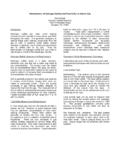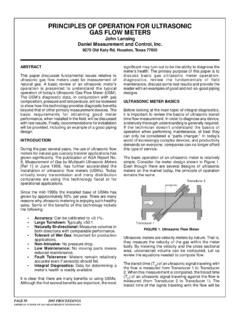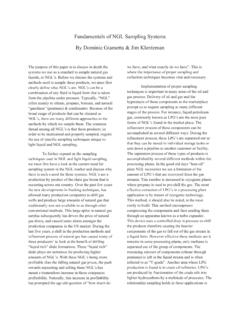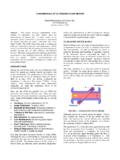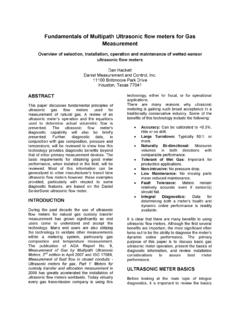Transcription of HYDROGEN SULFIDE MEASUREMENT AND DETECTION
1 2003 PROCEEDINGS PAGE 118 AMERICAN SCHOOL OF GAS MEASUREMENT TECHNOLOGYHYDROGEN SULFIDE MEASUREMENT AND DETECTIONP atrick J. Moore and Rodney W. SpitlerThermo Electron Corporation9303 W. Sam Houston Parkway S., Houston, Texas 77099 INTRODUCTIONThe impetus for measuring and detecting hydrogensulfide, H2S, as it relates to the production anddistribution of natural gas, is rooted in two primaryconcerns. The first concern deals with protectingpersonnel from the lethal effects of H2S. Typically, themaximum pipeline H2S concentration is around per 100 SCF, nominally 4 ppm/volume. At theseconcentrations H2S is not lethal and its presence can bedetected by the sense of smell with its characteristicrotten egg odor. At the higher lethal H2S concentrations,typically found at production and acid gas removalinstallations, the nose becomes desensitized.
2 Unable tosmell the H2S, a worker breathing such an atmosphereis oblivious to the life threatening second concern deals with preventing hydrogenembrittlement of the natural gas transmission lines. Whenhydrogen SULFIDE reacts with the metal in the transmissionline to form a metallic SULFIDE , the released HYDROGEN isthen free to migrate within the molecular structure of thepipe. Transmission lines weakened by embrittlement aresusceptible to rupture failure allowing for large clouds ofgasses to escape and accumulate in the only are such release clouds lethal by the depravationof life sustaining oxygen, a single spark can set off adevastating technologies are available for measuring anddetecting H2S. These technologies include on-linecontinuous analyzers, area monitors, test methods, andpersonal monitors. Proper use of these technologies cancontribute to the safe delivery of natural gas from thewell head to the H2S is a flammable gas, the flammable limits (43,000 ppm) to 46%, (46,0000 ppm) far exceedthe concentrations of concern for personnel protection,nominally 10 ppm, and pipeline transmission, 4 H2S is heavier than air, it will tend to accumulatenear the ground when leaked into the atmosphere.
3 Astanding individual overcome by H2S will most likelycollapse to where the H2S concentration is even H2S toxicity danger is a function of the concentrationand the time of exposure. Concentrations on the orderof 500 ppm can result in rapid collapse, unconsciousnessand death. Prolonged exposure to lower concentrationscan also lead to hemorrhaging and death. At lowconcentration H2S has a characteristic rotten egg odorthough, with sufficient exposure time, low H2 Sconcentrations can also deaden the sense of smell. HighH2S concentrations rapidly deaden the sense of respiration, throat and eye irritation, sleepiness,headache, and pain in the eyes are all symptoms ofhydrogen SULFIDE is plenty of available information regarding H2 Ssafety. Some of the web sites containing information onH2S are listed in Table 1 H2S Web 1 H2S Web ReferencesAgency Web AddressUSEPA w DETECTION FOR PERSONNEL PROTECTIONP ersonnel protection devices provide information to aworker regarding a contaminating componentconcentration in the air so that appropriate actions canbe taken in the event an undesirable contaminantconcentration is detected.
4 Such actions include, but arenot necessarily limited to, evacuation of the area, usinga self-contained breathing apparatus, turning onemergency ventilation system, and eliminating the sourceof the leak. H2S monitors for personnel protection canbe carried by the individual or fixed mounted for areamonitoring. H2S monitors typically use colorimetric orelectrical example of a colorimetric H2S sensor is an encasedroll of lead acetate impregnated paper tape, an exposurewindow, and a color chart. When moistened, the leadacetate impregnated paper tape will change color fromwhite to brown when exposed to H2S. Tape moisturizationis achieved by exhaling on the exposure window. Theamount of H2S present dictates how fast the colorchanges. The rate of tape color change and the staindarkness is directly proportional to the H2 Sconcentration.
5 The advantage of the colorimetric H2 Ssensor is that electrical power is not required 119 2003 PROCEEDINGSAMERICAN SCHOOL OF GAS MEASUREMENT TECHNOLOGYE lectrical H2S sensor technologies include metal oxidesensors, sometimes called solid ceramic-metallic(cermet) film devices, and electrochemical cells. Eachof these devices depends on the migration of H2S fromits source to the sensor and can be incorporated into afixed-point DETECTION system or carried by the personal protection monitor, sometimes referred to asa multimeter, will typically contain a flammable gasdetector and an oxygen deficiency sensor in addition toa device to detect H2S. The migrated H2S reacts withthe surface of the metal oxide sensor, or the reagentchemical in the electrochemical cell, to create anelectronic signal.
6 In order for the generated signal to haveany meaning, the response of the device must becalibrated with a gas containing a known concentrationof H2S. The surface of the metal oxide sensor regeneratesitself in the presence of air. Electrochemical cells have afixed quantity of reagent that must be replaced mounted electrical H2S sensors, powered by abattery or a fixed electrical source, sound an alarm whenthe H2S concentration reaches a predetermined using relays, the electrical H2S sensors can alsoactivate emergency control apparatus, such as,ventilation and alarm systems, when an alarm conditionis MEASUREMENT IN GASESV arious organizations, such as ASTM, UOP, and GPA, toname three, publish test methods for measuring not onlyhydrogen SULFIDE but also a wide range of componentsand properties. Published test methods provide a wayto standardize test procedures so that the results fromone location are comparable to the results from anotherlocation.
7 Some of the available test methods formeasuring and detecting HYDROGEN SULFIDE are listed inTables 2 ASTM Methods for MEASUREMENT of H2S ASTMM ethods DescriptionD2420-91 Standard Test Method for HYDROGEN SULFIDE in(1996)e1 Liquefied Petroleum (LP) Gases (Lead Acetate Method)D4084-94 Standard Test Method for Analysis of HYDROGEN Sulfide1999in Gaseous Fuels (Lead Acetate Reaction Rate Method)D4323-84 Standard Test Method for HYDROGEN SULFIDE in the(1997)e1 Atmosphere by Rate of Change of ReflectanceD4913-00 Standard Practice for Determining Concentration ofHydrogen SULFIDE by Direct Reading Length of Stain,Visual Chemical DetectorsD4952-02 Standard Test Method for Qualitative Analysis for ActiveSulfur Species in Fuels and Solvents (Doctor Test)D5504-01 Standard Test Method for Determination of SulfurCompounds in Natural Gas and Gaseous Fuels by GasChromatography and ChemiluminescenceD6228-98 Standard Test Method for Determination of SulfurCompounds in Natural Gas and Gaseous Fuels by GasChromatography and Flame Photometric DetectionTable 3 GPA Methods for MEASUREMENT of H2 SGPA Methods DescriptionStandard 2285 GPA Standard for Determination of HYDROGEN Sulfideand Mercaptan Sulfur in Natural Gas (CadmiumSulfate-Iodometric Titration Method)
8 Standard 2377 Test for HYDROGEN SULFIDE and Carbon Dioxide inNatural Gas Using Length of Stain TubesTable 4 UOP Methods for MEASUREMENT of H2 SUOP Methods Description9-85 HYDROGEN SULFIDE in Gases by the Tutwiler Method41-74 Doctor Test for Petroleum DistillatesSelecting a test method to detect and measure hydrogensulfide will depend on the desired degree of test methods are designed to provide approximateresults while others are design to provide a greater degreeof example of an approximate method is the Doctor Doctor Test involves passing a H2S containing gasacross a filter paper wetted with an aqueous lead oxidesolution and observing a color change. The lowerdetectable limit is about grains per 100 SCF, or ppm/v. A dark brown color is indicative ofconcentrations above grains per 100 SCF, or about8 ppm/v (Pender, 1986).
9 Another approximate method involves using glass staintubes filled with lead acetate. As a known volume of gasis drawn through the tube, the lead acetate changes fromwhite to brown. The amount of color change dependson the amount of H2S in the gas. The greater the H2 Sconcentration the greater the color change. Tubes forvarious concentration ranges are methods to detect and measure H2S are basedon wet chemical procedures. An example of a wetchemical method is GPA Standard 2285 which isapplicable for determining the H2S content of natural this method an extracted sample is passed through acadmium sulfate (CdSO4) solution. The absorbed H2 Sreacts to form cadmium SULFIDE (CdS) which is thenmeasured iodometrically. Another example of a wetchemical method is the portable titrator that uses anelectric current passing through a reagent electrolyticsolution, such as bromine, while the H2S containing gasis bubbled through the solution.
10 The net generatingcurrent needed to maintain a slight excess of reagentsolution is directly proportional to the concentration ofthe reactant (H2S).Some of the methods listed in Tables 2-4 are availableas on-line instrumentation. On-Line instruments offer theadvantage of providing analytical information twenty-fourhours a day seven days a week. Included in this categoryare gas chromatographs and lead acetate PROCEEDINGS PAGE 120 AMERICAN SCHOOL OF GAS MEASUREMENT TECHNOLOGYEach is an extractive type analyzer in that the sample isextracted from the process and is transported to theanalyzer for chromatography involves injecting a known volumeof sample into a carrier stream. The sample-containingcarrier then passes through a column where thecomponents of the sample are separated from eachother.
